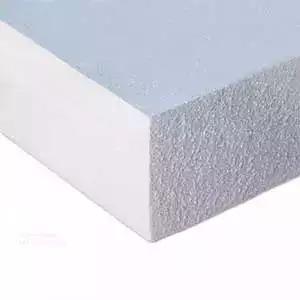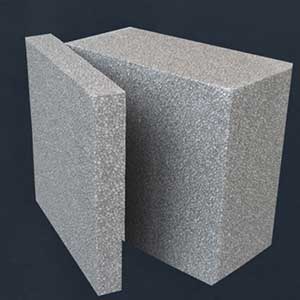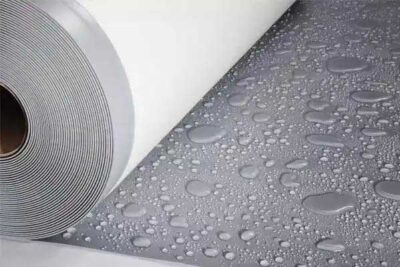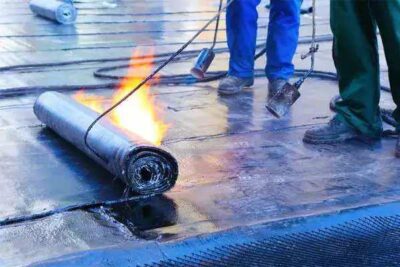
Contents
Thermal insulation foams are inert air (or other gas) trapped in small spaces that provide thermal insulation. Gases have very low thermal conductivity by conduction (vibration of atoms or molecules). But when molecules find a space to move around, they conduct significant heat by convection. When the voids in the material become larger or interconnected, the thermal conductivity of the air (or gas) and therefore the material increases. When the water content of the material increases, the thermal conductivity of the material increases.
Thermal Insulation Foams; There are many ways to insulate, including rigid insulation foam, spray foam insulation, fiberglass insulation, blown in cellulose insulation, and others. Typical applications for each insulation type are:
- Rigid Insulation Foam – Exterior walls of homes and under the foundation.
- Spray Foam – Sprayed into the wall cavity, typically in new builds prior to drywall.
- Fiberglass Felt – Usually in new construction, it is rolled into the wall space between the studs.
- Cellulosic Blown – Popular in remodeling projects; Holes are cut in the wall or sprayed into the attic to fill the gap with insulation.
Although insulating a structure can reduce sound transmission and create a quieter interior, rigid insulation foam is not designed for soundproofing. Open cell insulation products are more suitable for reducing sound transmission, while closed cell insulation is better for providing insulation value.
In this article, we will focus on rigid insulation foam for use in wall applications, comparing three popular types:
- Expanded Polystyrene (EPS)
- Extruded Polystyrene (XPS)
- Graphite Polystyrene (GPS, Neopor)
Expanded Polystyrene (EPS) Insulation
 What is EPS?
What is EPS?
EPS is an extremely lightweight product made from expanded polystyrene beads. Discovered in Germany, EPS thermal insulation foam is more than 95% air and only about 5% plastic. Small solid plastic particles of polystyrene are made from the monomer styrene. Polystyrene is normally a solid thermoplastic that can be melted at a higher temperature at room temperature and resolidified for desired applications. The expanded version of polystyrene is about forty times the volume of the original polystyrene granule.
Expanded Polystyrene Insulation, commonly referred to as EPS, is a closed cell insulation that has been around since the 1950s. EPS is made of 98% compressed air and only 2% plastic and is an efficient insulator with little raw material.
EPS foams are versatile because they can be molded and cut into different shapes. Contoured EPS not only acts as insulation, but also provides greater durability and impact resistance to the coating.
Polystyrene is one of the most used plastic types. It is a polymer made from the monomer styrene, a liquid hydrocarbon produced commercially from petroleum by the chemical industry. Polystyrene is a thermoplastic material, it melts when heated and becomes solid again when cooled.
How is EPS Made?
EPS thermal insulation foams start out as tiny grains of polystyrene that look like grains of salt. The beads are sent into a mold and expanded to most of their original size using steam and pentane until they completely fill the cavity. While typically white in color, EPS may contain additives such as colorants or pest inhibitors.
If the mold is in the final product form, the part is removed from the machine and the process is complete. More commonly, the beads are molded into a large rectangular block and then cut into the final shape using hot wires. From there, the EPS insulation is then packaged and shipped or shipped through another machine that seals the plastic film faces to the foam. Depending on the particular film used, it can provide enhanced durability, reflective properties, printed installation lines and more. Most EPS insulation manufacturers print their brand name and important product information on the film.
EPS thermal insulation foams are specially designed with galvanized steel joist strips embedded directly into rigid foam plastic insulation with a polymeric laminate applied to each panel surface.
EPS foams are non-structural and are used as both exterior and interior insulation, although they can be used throughout the structure on roofs, floors and ceilings. Manufacturers can also provide the builder with insulation of varying density, possibly resulting in increased stud width to a structure that meets or exceeds energy code standards at no additional cost. When higher R-value is required; EPS foam can be produced to a higher density instead of adding layers of harder insulation materials.
The conversion of EPS to expanded polystyrene is carried out in three stages: Pre-expansion, Maturation / Stabilization and Molding
Polystyrene is produced from crude oil refinery product styrene. For EPS production, polystyrene beads are impregnated with foam-forming pentane. Polystyrene granulate pre-foams at temperatures above 90°C. This temperature causes the foaming agent to evaporate, thereby swelling the thermoplastic base material to 20-50 times its original size. After that, the beads are stored for 6-12 hours to reach equilibrium. The beads are then moved into the mold to produce suitable forms according to the application.
In the final stage, the stabilized beads are molded into large blocks (Block Molding Process) or designed into special shapes (Shape Molding Process). The material can be modified by adding additives such as flame retardant to further increase the fire behavior of EPS.
What are the Basic Features of EPS Thermal Insulation Foams?
In any insulation, energy efficiency is the primary feature. The energy efficiency of insulation products is measured as the “R-value” or resistance to heat flow. The higher the R-value, the higher the insulating ability. EPS insulation has an average R-value of 3.6 per inch. When certain types of plastic surfaces are applied, the composite product can have an R-value of up to 3.8 per inch.
In addition to providing energy efficiency, EPS without film faces has a perm rate of up to 5.0. Perm rating is a measure of a product’s ability to allow water vapor to pass through it.
The average family of four produces 4 to 6 gallons of steam each day. Higher perm grade products allow this steam to escape, eliminating the potential for moisture damage.
When it comes to cost, EPS generally has the lowest price tag of the three insulation types described in this article.
EPS Data Summary:
Cell Type: Closed
R-value: 3.6 per inch, 3.8 with film face
Perm Rating: Up to 5.0
Cost: Contact…
Extruded Polystyrene (XPS) Insulation

What is XPS?
XPS thermal insulation foam is rigid foam that resists water absorption, providing a strong, lightweight and flexible insulation solution, making it ideal for a range of building and commercial applications. It is suitable for use in wall and ceiling insulation, cool rooms and cooling, under concrete slab (i.e. parking lot) and even in architectural modeling or hobby model making.
Extruded Polystyrene, called XPS, is a closed-cell insulation product commonly used in remodeling and new construction applications. Because of the manufacturing process, XPS insulation is typically only available in standard size square or rectangular boards.
The most common components of a building envelope perform important functions, but do not always fulfill their true potential. To this end, a variety of plastic materials can help building owners achieve the efficiency they need. XPS thermal insulation foam offers many benefits due to the way it is manufactured. Energy efficient, easy to install, lightweight and recognizable by its blue, pink or green colours, the properties of the extruded polystyrene foam envelope can allow the use of a single product to create a building’s continuous layer of thermal and moisture protection, contributing to energy efficiency.
The closed cell structure of XPS thermal insulation foams provides excellent long-term strength and durability. Products are available in a variety of compressive strengths to suit various application needs. Due to its inherent physical properties, this strength is not dependent on the use of substrates or laminates, which can sometimes be compromised during installation. However, XPS foam faced products are available to add extra strength when specified for a particular application. XPS insulation foam comes in a wide variety of sizes and thicknesses up to 102mm to suit many applications.
How is XPS Made?
XPS insulation starts as polystyrene crystals combined with special additives and a gas blowing agent. The materials are fed into an extruder where they are mixed and melted into a thick liquid. The liquid is processed through a die, expanded into foam, shaped, cooled and finally cut.
XPS thermal insulation foams start as a solid granule of polystyrene resin. Plastic granules are fed into an extruder, where they are melted and mixed with critical additives to form a viscous liquid. A blowing agent is then injected to cause the plastic product to expand. Under carefully controlled conditions of heat and pressure, the plastic mixture is forced out of a mold into the desired shape. Rigid foam plastic is then cut to final product dimensions and is often recognized as sheets.
This continuous process produces a closed-cell structure that resembles a mass of uniform bubbles with common walls between them. A continuous smooth skin is also formed above and below.
Energy Efficiency with XPS Foam
XPS thermal insulation foams have positive energy and air emission benefits when used in residential buildings. Research shows that using XPS foam insulation saves more energy than producing insulation over the 50-year life of a decent home. For more than three years, more greenhouse gas emissions are avoided than are emitted during the production of XPS foam insulation jacket due to heating/cooling energy consumption.
Properly installed XPS thermal insulation foams increase the energy efficiency of a building by providing a complete insulation layer to the wall. This reduces air movement through the wall, which can waste energy. Insulation between studs does not necessarily offer full insulation value because the wood studs and other framing members are not insulated. This phenomenon is called thermal bridging and can significantly reduce the thermal performance of the building.
Because residential wood framing usually makes up about 25 percent of the wall area (taking into account the window and door framing), a quarter of the wall is not insulated when only gap insulation is used. As such, the XPS foam coating provides insulation value to the entire wall area. Besides its linear insulation performance, XPS insulation foam also greatly reduces air leakage through walls, which can improve energy efficiency and comfort when properly installed.
A key characteristic for sustainable building products, especially insulation, is the ability to function properly throughout its life without deterioration in physical property performance. In fact, long-term insulation performance is needed to properly design a building’s heating and air conditioning systems.
XPS thermal insulation foams have advantages due to their ability to help with moisture management by resisting both water absorption and freeze/thaw cycles. When traditional insulation absorbs water, its thermal performance can be compromised over time.
What are the Basic Features of XPS Thermal Insulation Foams?
Just like EPS, the main feature of XPS thermal insulation foams is energy efficiency. Because of its physical properties, XPS has a higher R-value than EPS at 4.7 per inch.
In the past, XPS manufacturers have been able to demand R-values close to 5.0 per inch. However, the blowing agents used in the manufacturing process are known to consume overtime and reduce the insulation value. Manufacturers report the Long Term Thermal Resistance (LTTR) of XPS products, which takes into account the decrease in R-value over time.
XPS provides greater rigidity and strength, making it suitable for use on roofs, under flooring and in other applications.
XPS Data Summary:
Cell Type: Closed
R-value: 4.7 per inch
Perm Score: <1.0 – 1.5
Cost: Contact…
Graphite Polystyrene (GPS, Neopor)

What is GPS (Neopor)?
Graphite polystyrene insulation, or GPS, is made of Neopor beads, patented and manufactured by BASF. Neopor gives GPS insulation a darker gray appearance and higher r-value than traditional EPS insulation products. For more information about Neopor, click here.
How is GPS Made?
GPS is manufactured like EPS insulation. The primary difference is the Neopor raw material production. BASF, the world’s largest chemical company, fills the cell structure with graphite particles that provide a reflective property and a distinctive dark gray color.
Neopor beads are sent into a mold and hit with steam and pentane until they expand many times to their original size and fill the void. Since Neopor is a naturally dark grayish black color, color additives are not usually used.
After the molding process is complete, the insulation blocks are then aged and cut into the final shape using hot wires. Plastic film coaters can also be bonded to the foam to provide tougher, reflective properties, mounting guides and more.
Some manufacturers produce both EPS and GPS because the manufacturing process is very similar to EPS. This usually requires some additional equipment to prevent cross-contamination between the two types of insulation.
What are the Main Features of GPS Thermal Insulation Foams?
The main characteristic of GPS (Neopor) thermal insulation foams is 4.7 per inch, which is achieved thanks to the high purity graphite placed in the cell structure of the insulation.
Traditional EPS saves energy due to trapped air pockets in the insulation; this slows down the warm air as it moves towards the cold air. This is an energy-saving feature.
As the radiant heat travels through the GPS insulation, it is reflected hundreds of times along the way thanks to the graphite particles, significantly slowing the heat transfer and making the insulation more energy efficient. When some types of plastic surfaces are applied, GPS can have an R value of up to 4.9 per inch.
In addition to providing energy efficiency, GPS insulation without film surfaces has a permit rating of up to 5.0 depending on the density from which it is produced. Perm rating is a measure of a product’s ability to allow water vapor to pass through it.
GPS insulation is more expensive than EPS due to increased energy savings, but is generally less expensive than XPS insulation.
GPS Data Summary:
Cell Type: Closed
R-value: 4.7 per inch, 4.9 with film layer
Perm Rating: Up to 5.0
Cost: Contact Us…
In summary;
Depending on your particular application, EPS, XPS, or GPS insulation may be right for your project. Cost, availability, and certain performance characteristics can all influence your decision. Fortunately, no matter which product you choose, insulating a house is always a great investment in terms of national economy and energy savings.
We recommend that you choose the product that will provide the most value for your investment. If you are installing insulation under a new roof or under flooring, XPS can be an effective solution. If your insulation needs are for sidewall applications before siding is installed, we recommend using a contoured EPS or GPS insulation that not only insulates but also provides durability and long-term support to the siding panel.







